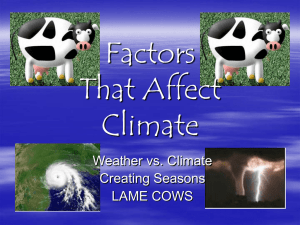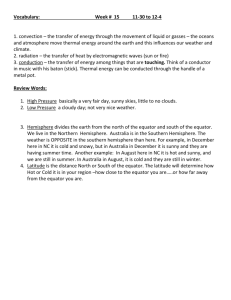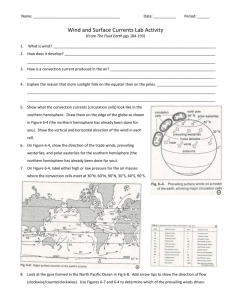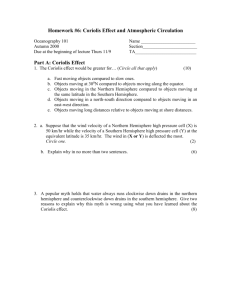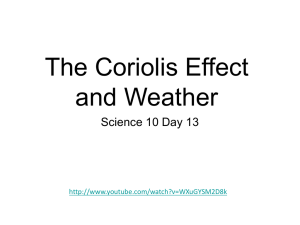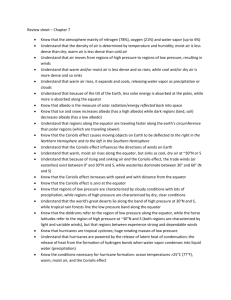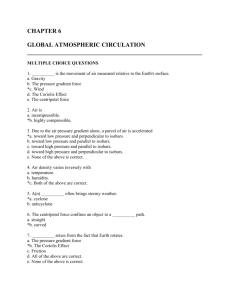Wind – horizontal motion of air across the Earth`s surface
advertisement
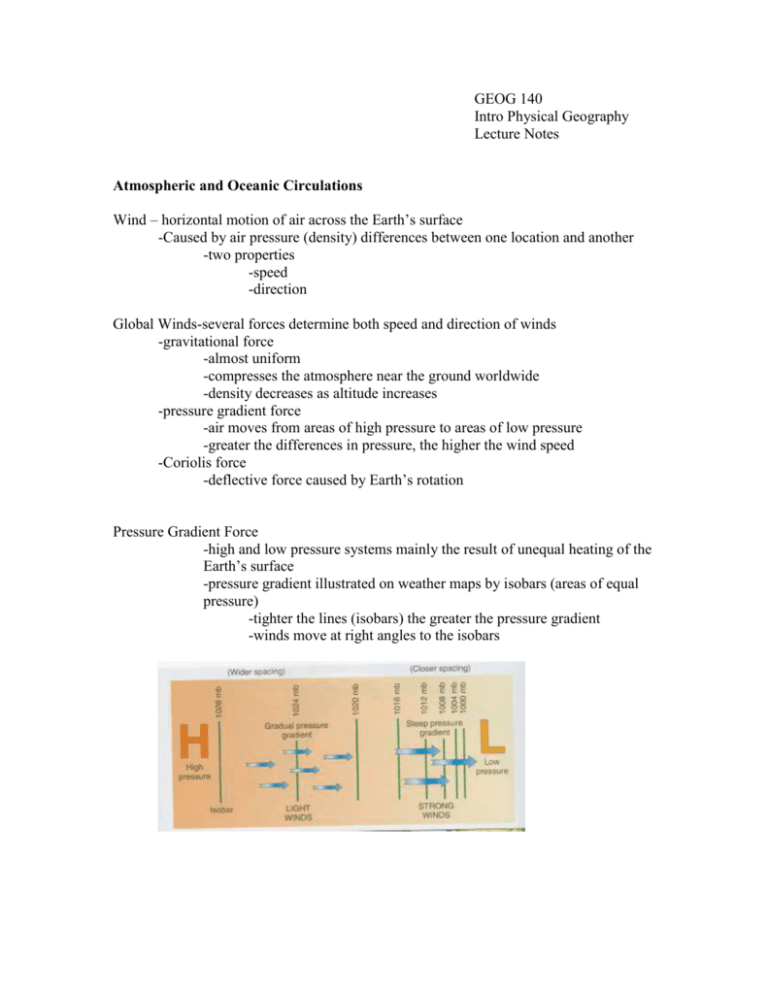
GEOG 140 Intro Physical Geography Lecture Notes Atmospheric and Oceanic Circulations Wind – horizontal motion of air across the Earth’s surface -Caused by air pressure (density) differences between one location and another -two properties -speed -direction Global Winds-several forces determine both speed and direction of winds -gravitational force -almost uniform -compresses the atmosphere near the ground worldwide -density decreases as altitude increases -pressure gradient force -air moves from areas of high pressure to areas of low pressure -greater the differences in pressure, the higher the wind speed -Coriolis force -deflective force caused by Earth’s rotation Pressure Gradient Force -high and low pressure systems mainly the result of unequal heating of the Earth’s surface -pressure gradient illustrated on weather maps by isobars (areas of equal pressure) -tighter the lines (isobars) the greater the pressure gradient -winds move at right angles to the isobars -high pressure areas – descending, diverging airflows -low pressure areas-ascending, converging airflows Coriolis Force -appears to deflect wind from a straight path -Northern Hemisphere-to the right -Southern Hemisphere-to the left -increases from the Equator (zero) to the poles (maximum) -pressure gradient + coriolis force =geostrophic wind -wind flows parallel to isobars (balance between pressure gradient and deflection of Coriolis force -high and low pressure areas develop rotary motion -Northern Hemisphere high (anticyclone) –clockwise -Northern Hemisphere low (cyclone) - counterclockwise -wind flowing between highs and lows Friction Force -effect of surface friction extends to a height of about 500 meters (1650 ft) -varies with -surface texture -wind speed -time of day and year -atmospheric conditions -near surface-disrupts the balance between pressure gradient and Coriolis force -close to surface –friction decreases wind speed which reduces Coriolis force -wind crosses isobars at an angle Global Patterns of Pressure -Four pressure areas located in Northern Hemisphere and four located in Southern Hemisphere -two (in each hemisphere) result of temperature factors -equatorial low-pressure trough (warm/wet) -polar high-pressure cells (cold/dry) -two (in each hemisphere) result of dynamic factors -subtropical high-pressure cells (hot/dry) -subpolar low-pressure cells (cool/wet) -Equatorial low-pressure trough -narrow band of low pressure circling the Earth -constant high sun and consistent daylength -warmer creates lighter, less dense, ascending air -converging moist air (full of latent heat) -vertical clouds with heavy rain -line of cloud cover in equatorial regions -Intertropical Convergence Zone (ITCZ) -migrates in the tropics in response to the subsolar point -air converges from both sides of the equator -northeast and southeast trades -hadley cell circulation -at the equator/ITCZ lack of winds-duldrums -Subtropical high pressure cells –hot dry desert air -20o-35o latitude in both semesters -broad zone of hot dry air -absence of clouds on satellite images -decending air of Hadley cell circulation -decending air compresses and heats -hotter air has high moisture capacity -air is actually dry because the majority of the moisture falls over equator -Subpolar –low pressure cells -cool and moist air -two cells at around 60o N latitude in winter -Aleutian low -Icelandic low -weaken/disappear in summer with strengthening of high in subtropics -contact zone –polar front -discontinuous belt surrounds Antarctica -Polar high-pressure cells- frigid dry deserts -weak polar high pressure cells (Anatarctic high more pronounced) -anticyclonic winds move away from the poles -decending and diverging -clockwise –N. Hemisphere -counterclockwise-S. Hemisphere -polar easterlies –weak, variable winds Upper Atmospheric Circulation -Rosby waves -Jet Streams Local Winds -Land-sea breezes -Mountain-valley breezes -Kadiabatic winds Monsoonal Winds Oceanic Currents -surface currents -ocean currents driven by the circulation around subtropical high pressure cells -Northern Hemisphere-winds and ocean currents move clockwise -Southern Hemisphere-winds and ocean currents move counterclockwise -along the equator -tradewinds force water westward -coriolis force keeps flow constrained in a narrow band (coriolis force zero at the equator) -as water reaches western edge of ocean it “piles up” and spills north and southward in strong currents -Gulf Stream_Atlantic -Kuroshio-Pacific -deep currents -surface water swept away from coasts replaced by upwelling current -cold, nutrient rich water rises from great depths -Pacific Coasts of N. and S. America -tropical/mid latitude west Coast of Africa -surface water piles up and sinks -water gravitates downward in a downwelling current -important mixing currents run along ocean floor -transport heat energy


